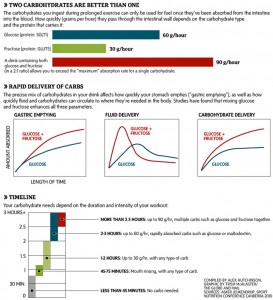THANK YOU FOR VISITING SWEATSCIENCE.COM!
My new Sweat Science columns are being published at www.outsideonline.com/sweatscience. Also check out my new book, THE EXPLORER'S GENE: Why We Seek Big Challenges, New Flavors, and the Blank Spots on the Map, published in March 2025.
- Alex Hutchinson (@sweatscience)
***
Great first day at the International Sport Nutrition Conference in Canberra. Several interesting sessions that I’ll post about in days to come. For now, since I have just a few minutes before dinner, a few notes about Asker Jeukendrup‘s session, which he called “Carbohydrate: boring old or exciting new?”
In the “boring old” category, he took aim at the ACSM’s position stand, which states:
For longer events, consuming 0.7 g carbohydrates/kg body weight/h (approximately 30-60 g/h) has been shown unequivocally to extend endurance performance.
Now, it’s well known that if you take a drink with glucose in it, the fastest you can possibly make use of it is at a rate of about 0.8-1.0 g/min, no matter how much carb you have. The rate-limiting step is absorption from the intestine, which doesn’t depend at all on how big or small you are, so the guidelines shouldn’t be expressed “per kg body weight” — it should just be 30-60 g/hr (with the high end corresponding to the 1.0 g/min which is the fastest we can make use of glucose).
However, there are ways around this rate-limiting step. Over the last five or six years, Jeukendrup’s group has done a long series of studies on combining glucose and fructose. On its own, fructose is absorbed slower that glucose. But it’s transported across the intestinal wall by a different mechanism, so you can have both glucose and fructose being absorbed at the same time. Add them together, and you can get about 1.7 g/min that the body actually makes use of. (And this is, indeed, the formulation used in Power Bar’s “C2 Max carb mix” bars and gels.) So Jeukendrup suggests that ultra-endurance athletes should aim for closer to 90 g/hr of carbs, and he showed some data from Ironman triathlete Chrissie Wellington, who does precisely that (and who just set a new Ironman world record in Arizona).
Does this apply to everybody? Well, it’s not such a big deal for shorter events. He offered these loose guidelines (which I copied down quickly — if I made any mistakes, I’ll correct them when I get the official proceedings):
- less than 45 min: no carbs needed (but he later noted that some new studies are now showing that “mouth rinsing” with carbs can have an effect with exercise bouts as short as 30 min)
- 45-75 min: mouth rinsing, with any type of carb
- 1-2 hr: up to 30 g/hr, any type of carb
- 2-3 hr: up to 60g/hr, carbs that are oxidized rapidly like glucose or maltodextrin
- more than 2.5 hrs: up to 90g/hr, MUST be a combination of carbs that are absorbed via different mechanisms (e.g. glucose or maltodextrine combined with fructose in a 2:1 ratio)
Anyway, that’s a quick overview of some of the take-home messages he offered. There was lots of discussion afterwards, so if you have any questions about any this stuff, feel free to post ’em in the comments section and I’ll answer if I can.

